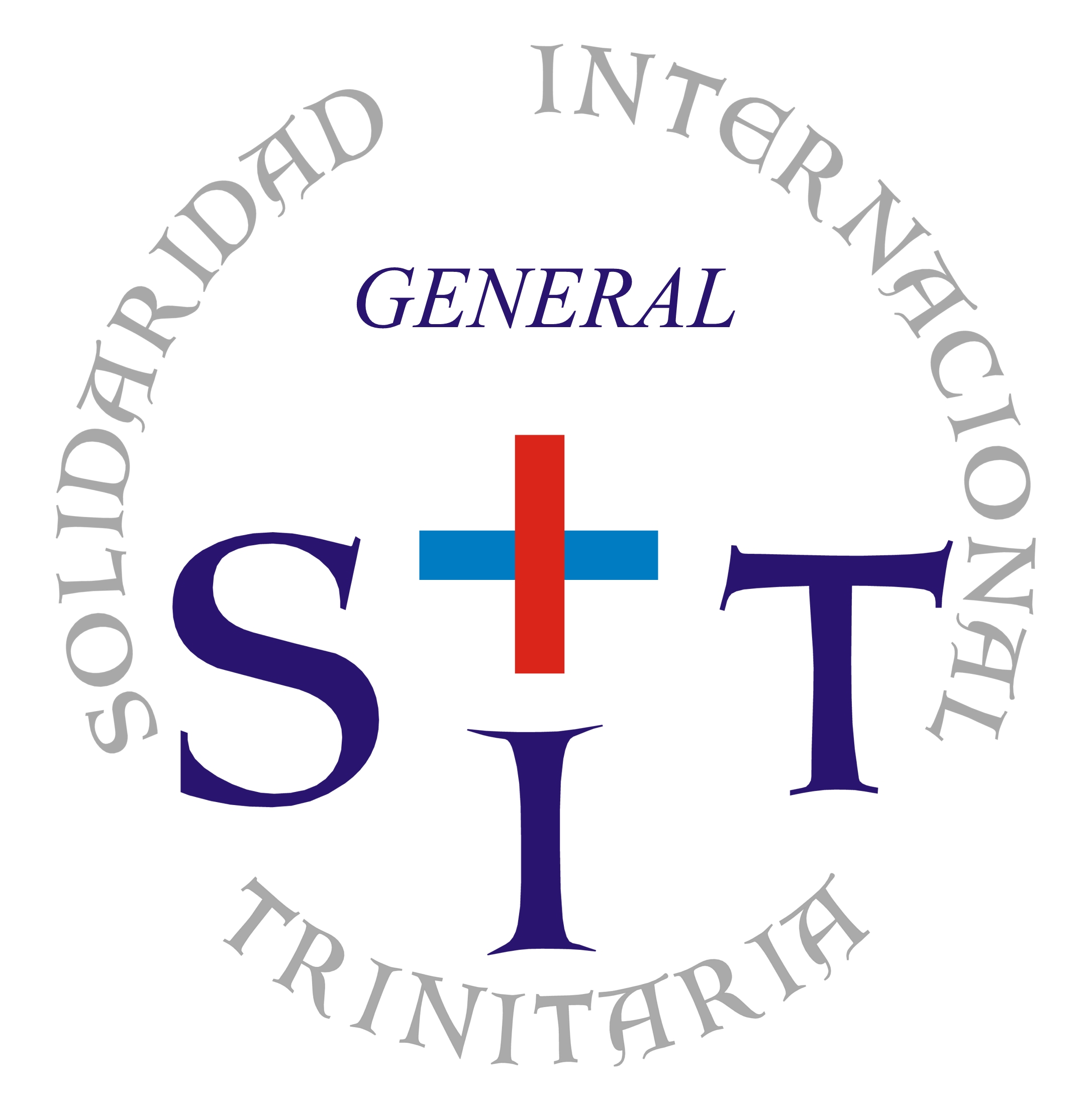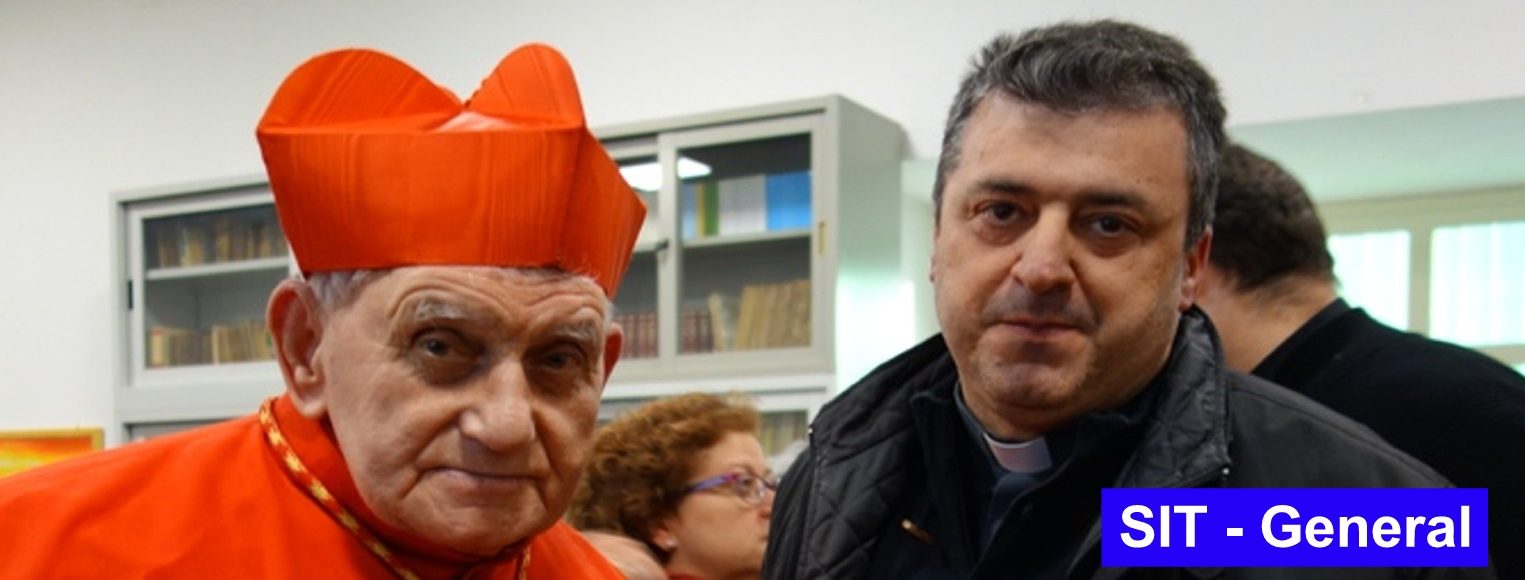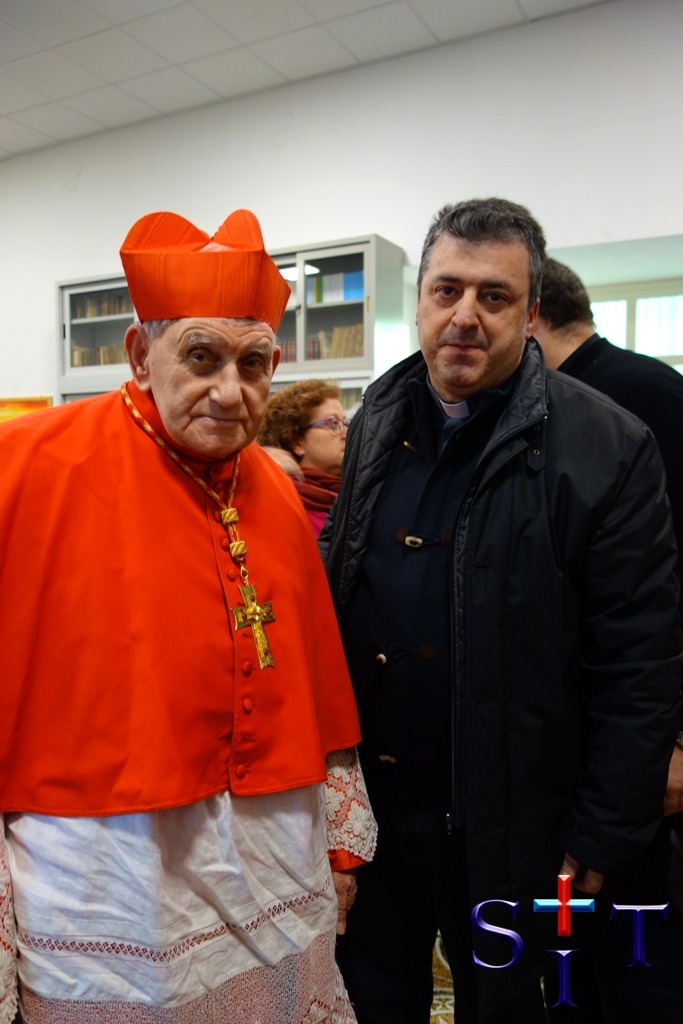Artículo del Vicario General de la Orden. Publicado en el Boletín del Cristo de la Veracruz.
LA CRUZ EN LA CLOACA.
Reflexión tras mi encuentro con el cardenal Ernest Simoni.
Publicado en Boletín del Cristo de la Veracruz, Villanueva del Arzobispo, mayo 2018.
Pedro Aliaga (Roma)
Los últimos días de febrero bajé a Nápoles, para asistir a un encuentro sobre persecución religiosa, organizado por SIT (Solidaridad Internacional Trinitaria) de Italia. Al día siguiente de llegar, me cuentan que ha nevado en Roma, cosa muy rara; la mañana del 27, al abrir la persiana de mi cuarto, me encuentro con los tejados blancos, cosa rarísima. Hacía 65 años que no nevaba en Nápoles, y me asomo a la parte opuesta a mi habitación para ver el volcán Vesubio con su cima blanqueada. Algunos de mis estudiantes (=seminaristas) montan la de San Quintín en el patio: es la primera vez que ven la nieve, y la disfrutan a lo grande.
Me habían dicho que en el encuentro iba a estar presente el cardenal Ernest Simoni, y efectivamente, allí estaba. Fueron tres los días que pasamos bajo el mismo techo, viviendo en nuestro convento. Había oído hablar de él desde que hizo llorar, literalmente, al papa Francisco. Fue en 2014 cuando el Pontífice hizo un viaje a Albania; una tarde estuvo reservada para un encuentro de recuerdo a los mártires y víctimas de la cruel persecución a la religión (católicos, ortodoxos y musulmanes) que perpetró el siniestro presidente Enver Hoxha, y allí se presentó don Ernest Simoni, un anciano sacerdote de 88 años: con una gran sencillez, contó cómo lo arrestaron la noche de Navidad de 1963, mientras celebraba la misa, atándole las manos con tanta fuerza que creía que se moría. La narración de sus sufrimientos durante los 28 años en que estuvo condenado a trabajos forzados, fue tan impactante, que el papa Francisco se echó a llorar.
En 2016, estaba un domingo oyendo la radio con su sobrino Antonio. El Papa Francisco anunció que iba a nombrar nuevos cardenales; entre los nombres, dijo el suyo. “Tío, el papa ha dicho que te ha hecho cardenal”. “Qué raro, será otro que se llama igual que yo”. Como recibió alguna llamada de personas que le daban la enhorabuena, don Ernest dijo a su sobrino: “Llama al Vaticano, y salimos de dudas”. El 19 de noviembre de 2016, el papa le imponía la birreta de color púrpura en una misa solemne celebrada en el Vaticano, pasando a ser cardenal de la Iglesia.
Observo al cardenal Simoni, que come junto a mí. En octubre cumplirá 90 años. Es un hombre de complexión fuerte, de pelo blanco; me llaman la atención sus manos, robustas, de hombre que ha trabajado duramente. Va con un jersey recio, lleva al cuello una cruz sencilla. Le gusta echar sal en la sopa, hay que ponerle el salero junto al plato. Hombre de pocas palabras, su sobrino Antonio (que lo acompaña siempre) está pendiente de él.
El día 26, por la tarde, don Ernest va a contar su testimonio a cuantos participan en el encuentro. Tengo que hacer la traducción simultánea al español, y me toca encerrarme en la cabina, ponerme los auriculares para oír directamente sus palabras y traducir al mismo tiempo por el micrófono al español. Estoy hecho a estos menesteres, pero esta vez me fastidia que la cabina está en una disposición que no me permite ver ni la sala ni al cardenal que habla.
Don Ernest empieza a hablar. Su italiano, no siendo muy bueno, es suficientemente comprensible. Nos cuenta su vida, con una sencillez pasmosa. Recuerda cómo la noche de Navidad en que lo arrestaron, mientras celebraba la misa, entraron policías que se colocaron en los cuatro ángulos de la iglesia; lo ataron, se lo llevaron, declarándolo enemigo del pueblo. Fue condenado a muerte, como tantos otros sacerdotes y creyentes de Albania.
Estando en el calabozo, un espía infiltrado se hizo pasar por preso, y estableció conversación con él, “tirándole de la lengua” para que criticara al Presidente Hoxha. Don Ernest respondió con sencillez, diciendo que Cristo mandó amar a todos, y no habló mal de nadie. La conversación fue grabada; el Presidente la escuchó y conmutó la pena de muerte por la de 25 años de trabajos forzados. Fueron 28, ya que estuvo preso hasta finales de 1990.
Pareciera como si hubieran querido que este hombre no volviera a ver la luz del sol: un período estuvo como minero, en las oscuras galerías de las minas de Spac, y después fue llevado a limpiar las cloacas de la ciudad de Scutari. Don Ernest nos cuenta los largos turnos de trabajo en las galerías de la mina, los compañeros que caían muertos por la extenuación y las enfermedades respiratorias, la poca comida del campo de concentración. Nos habla de las torturas sufridas, de las palizas en los pies. Pero también de que nunca renegó de la fe, ni de su sacerdocio, ni siquiera cuando le ofrecieron un trabajo de profesor en Tirana y casarse con una hermosa muchacha; “¡mi esposa es la Iglesia –les respondió- y es bien guapa!”. Don Ernest, en el campo de concentración, celebraba la misa “de memoria”, haciendo la forma con un poquito de harina cocida sobre un hornillo y el vino con un poco de zumo de uva. Confesaba a escondidas a los compañeros de prisión y les daba ánimos. Dentro de la cloaca de Scutari llegó a celebrar una misa para 180 personas; “si me hubieran descubierto, me habrían ahorcado”.
Su testimonio conmueve a la sala. Es un hombre de aspecto muy humilde, muy sencillo en su expresión. Sobre él sobrevuela una frase del periodista que lo ha presentado: “Este hombre que está delante de ustedes es un santo, y estoy seguro de que un día será canonizado”. Salgo de la cabina de traducción, y entre la mucha gente que se acerca a saludarlo, me abro paso y le digo: “Eminencia, ¿me puedo hacer una foto con usted?”.
Más tarde, en la cena, llevo conmigo el libro de oraciones que me acompaña a diario, el breviario, en el que rezo desde que entré en la Orden trinitaria. Cuando ha acabado su plato de sopa de verduras, lo abro por la primera página y le digo: “¿Me escribe una bendición, o lo que usted quiera?”. Sin descomponerse, don Ernest lo toma y escribe. Cuando me lo devuelve, aunque estudié paleografía, no logro entender lo escrito. Le pregunto. Y me contesta: “Muchas bendiciones de Jesús y de la Santísima Virgen”. La firma: “Ernest Cardenal Simoni”.
Esas “muchas bendiciones” de este santo mártir de nuestro tiempo se las pido al Señor para quienes leéis este boletín. Y os ruego una cosa: Cuando el 3 de mayo veáis por las calles al Santísimo Cristo de la Veracruz, acordáos de las muchas personas que en el mundo, hoy, sufren persecución por ser fieles a Jesús. No las olvidéis en vuestras oraciones.
[:en]
Article by the Vicar General of the Order. Published in the Bulletin of Cristo de la Veracruz.
THE CROSS IN THE SEWER.
Reflection after my meeting with Cardinal Ernest Simoni.
Published in Bulletin of Cristo de la Veracruz, Villanueva del Arzobispo, May 2018.
Rev. Pedro Aliaga, O.SS.T. Vicar General of the Order of the Most Holy Trinity and of the Captives (Rome)
The last days of February I went down to Naples, Italy to attend a meeting on religious persecution, organized by SIT (International Trinitarian Solidarity) of Italy. The day after arriving, they tell me that it has snowed in Rome, a very strange thing; On the morning of the 27th, when I opened the blinds of my room, I saw the snow-covered roofs, a very strange thing. It had been 65 years since it snowed in Naples, and I looked out from the opposite side of my room to see the top of Mount Vesuvius, the volcacno, covered in white snow. There’s a commotion in the courtyard because some of my students (= seminarians) are excited because it’s the first time they see snow, and they enjoy it in a big way.
I had been told that Cardinal Ernest Simoni was going to be present at the meeting, and indeed, there he was. We spent three days under the same roof, living in our convent. I had heard about him since he literally made Pope Francisco cry. It was in 2014 when the Pontiff made a trip to Albania; one afternoon was reserved for a memorial meeting for the martyrs and victims of the cruel religious persecution (Catholics, Orthodox and Muslims) perpetrated by the sinister President Enver Hoxha, and there was Ernest Simoni, an 88 year old priest: with great simplicity, he told how he was arrested on Christmas night in 1963, while celebrating the Mass, tying his hands with such force that he thought he was going to die. The story of his what he suffered during the 28 years in which he was condemned to hard labor, was so shocking, that Pope Francis burst into tears.
One Sunday in 2016, he was listening to the radio with his nephew Antonio. Pope Francis announced that he was going to appoint new cardinals; Among the names, he said his. “Uncle, the Pope said he made you a Cardinal.” “How strange, it must be someone else with my same name.” As he received calls from people who congratulated him, Don Ernest said to his nephew: “Call the Vatican, to clear all doubt.” On November 19, 2016, the pope placed the purple biretta on him at a solemn Mass celebrated in the Vatican, making him a Cardinal of the Church.
I looked at Cardinal Simoni, who was eating with me. In October he will be 90 years old. He is a man of strong build, with white hair; I am struck by his hands, they’re robust, hands of a man who has worked hard. He wears a sturdy sweater, and has a simple cross around his neck. He likes to put salt in his soup, we must put the salt shaker next to his plate. He is a man of few words, his nephew Antonio (who always accompanies him) is watching him.
On the 26th, in the afternoon, Don Ernest gives his testimony to all who participate in the meeting. I have to do the simultaneous translation into Spanish, and I have to lock myself in the booth, put on my headphones to hear his words directly and translate at the same time through the microphone into Spanish. I’ve done this before, but this time it bothers me that the cabin is in a position that does not allow me to see either the room or the cardinal who when he is speaking.
Don Ernest starts talking. His Italian, not being very good, is understandable enough. He tells us his life story, with stunning simplicity. Remember how on Christmas night when he was arrested, while celebrating the Mass, police officers entered from the four corners of the church; they tied him up, they took him away, declaring him an enemy of the people. He was condemned to death, like so many other priests and believers in Albania.
While in the dungeon, an infiltrated spy pretended to be a prisoner, and established a conversation with him, trying to get him to criticize President Hoxha. Don Ernest replied simply, saying that Christ commanded to love everyone, and did not speak ill of anyone. The conversation was recorded; the President listened to the recording and commuted the death penalty to 25 years of forced labor. They were 28, since he was imprisoned until the end of 1990.
It seems as if they did not want this man to see sunlight again: for a period was working as a miner, in the dark tunnels of the Spac mines, and then he was taken to clean the sewers of the city of Scutari. Don Ernest tells us about the long work shifts in the tunnels of the mine, about his companions who died due to exhaustion and respiratory diseases, the little food in the concentration camp. he tells us about the tortures he suffered, the beatings on the bottom of his feet. But also that he never denied the faith, nor his priesthood, not even when he was offered a teaching job in Tirana and to marry a beautiful girl; “My wife is the Church,” he replied, “and she’s very pretty!” Don Ernest, in the concentration camp, celebrated the Mass “from memory”, making the host with a little flour cooked on a stove and wine with a little grape juice.
He confessed his fellow prisoners secretly and encouraged them. Inside the cloister of Scutari he celebrated a Mass for 180 people; “If they had discovered this, they would have hanged me.” His testimony moves the room. He is a man of very humble appearance, very simple in his expression. Above him there is a banner with a phrase of the journalist who introduced him: “This man who is before you is a saint, and I am sure that one day he will be canonized.”
I leave the translation booth, and join the many people who come to greet him, I make my way to him and say: “Eminence, can I take a picture with you?”. Later, at dinner, I carry with me the prayer book that accompanies me daily, the breviary, which I pray since I entered the Trinitarian Order. When he finished his plate of vegetable soup, I open it on the first page and say: “Write me a blessing, or whatever you want?”. Without hesitation, Don Ernest takes it and writes in it. When he returns it to me, although I studied paleography, I can not understand the writing. I ask him. And he replies: “Many blessings of Jesus and of the Blessed Virgin”. The signature: “Ernest Cardenal Simoni”. Those “many blessings” of this holy martyr of our time I ask the Lord for those who read this bulletin. And I beg you one thing: When you see the Holy Christ of the Veracruz on the streets on May 3, remember the many people in the world who are persecuted today because they are faithful to Jesus. Do not forget them in your prayers.


